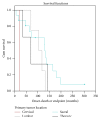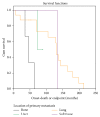Characteristics and Patterns of Metastatic Disease from Chordoma
- PMID: 26843835
- PMCID: PMC4710904
- DOI: 10.1155/2015/517657
Characteristics and Patterns of Metastatic Disease from Chordoma
Abstract
Chordoma is a rare, slow-growing malignant tumor arising from notochordal remnants. A retrospective review of patient records at two major referral centers was undertaken to assess the incidence, location, and prognostic factors of metastatic disease from chordoma. 219 patients with chordoma (1962-2009) were identified. 39 patients (17.8%) developed metastatic disease, most frequently to lung (>50%). Median survival from the time of initial diagnosis was 130.4 months for patients who developed metastatic disease and 159.3 months for those who did not (P = 0.05). Metastatic disease was most common in the youngest patients (P = 0.07), and it was 2.5 times more frequent among patients with local recurrence (26.3%) than in those without (10.8%) (P = 0.003). Patient survival with metastatic disease was highly variable, and it was dependent on both the location of the tumor primary and the site of metastasis. Metastasis to distal bone was the most rapid to develop and had the worst prognosis.
Figures



References
-
- Healey J. H., Lane J. M. Chordoma: a critical review of diagnosis and treatment. Orthopedic Clinics of North America. 1989;20(3):417–426. - PubMed
-
- Sciubba D. M., Cheng J. J., Petteys R. J., Weber K. L., Frassica D. A., Gokaslan Z. L. Chordoma of the sacrum and vertebral bodies. The Journal of the American Academy of Orthopaedic Surgeons. 2009;17(11):708–717. - PubMed
-
- Chambers P. W., Schwinn C. P. Chordoma. A clinicopathologic study of metastasis. American Journal of Clinical Pathology. 1979;72(5):765–776. - PubMed
LinkOut - more resources
Full Text Sources
Other Literature Sources

